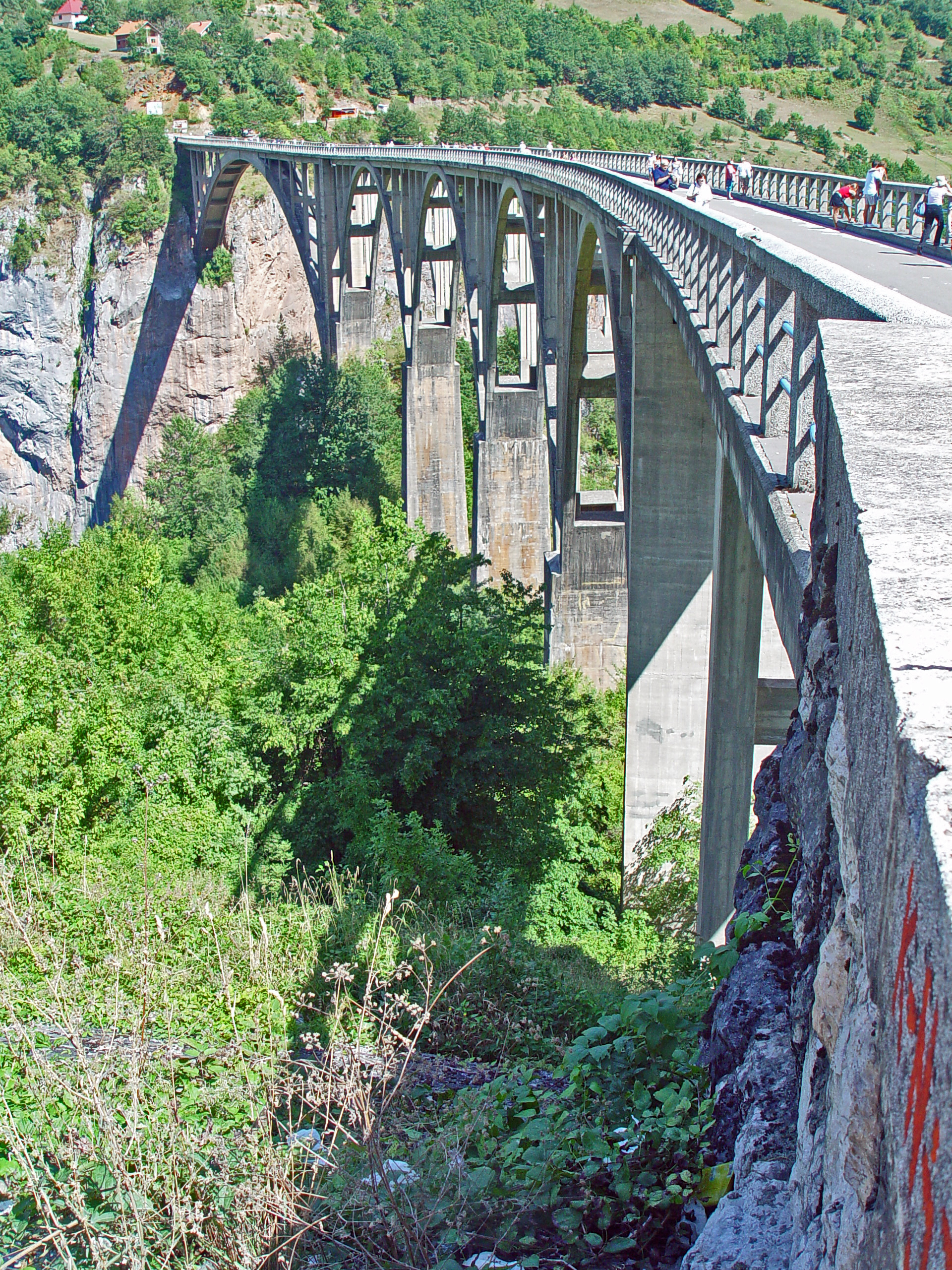Đurđevića Tara Bridge on:
[Wikipedia]
[Google]
[Amazon]
The Đurđevića Tara Bridge ( cyrl, Мост на Ђурђевића Тари, Most na Đurđevića Tari, ) is a 
concrete
Concrete is a composite material composed of aggregate bound together with a fluid cement that cures to a solid over time. It is the second-most-used substance (after water), the most–widely used building material, and the most-manufactur ...
arch bridge
An arch bridge is a bridge with abutments at each end shaped as a curved arch. Arch bridges work by transferring the weight of the bridge and its structural load, loads partially into a horizontal thrust restrained by the abutments at either si ...
over the Tara River in northern Montenegro
, image_flag = Flag of Montenegro.svg
, image_coat = Coat of arms of Montenegro.svg
, coa_size = 80
, national_motto =
, national_anthem = ()
, image_map = Europe-Mont ...
.
It is located at the crossroads between the municipalities
A municipality is usually a single administrative division having municipal corporation, corporate status and powers of self-government or jurisdiction as granted by national and regional laws to which it is subordinate.
The term ''municipality' ...
of Mojkovac
Mojkovac ( Montenegrin Cyrillic: –ú–æ—ò–∫–æ–≤–∞—Ü, ) is a town in Montenegro in the northern region. It has a population of 2,506 (2023 census). Mojkovac is the centre of Mojkovac Municipality, which has a population of 6,824.
Geography
The mu ...
, Pljevlja
Pljevlja (, ) is a town located in the Northern Montenegro, Northern Region of Montenegro, situated along Ćehotina, Ćehotina river.
The town lies at an altitude of . In the Middle Ages, Pljevlja had been a crossroad of the important commercial ...
and ≈Ωabljak
≈Ωabljak (Cyrillic script, Cyrillic: –ñ–∞–±—ô–∞–∫, ) is a small town in Montenegro in the Northern Montenegro, northern region. It has a population of 1,723.
≈Ωabljak is the seat of ≈Ωabljak Municipality (2011 population: 3,569). The town is in ...
. The exact location of the bridge is between the villages of Budečevica and Trešnjica.

Construction
The Đurđevića Tara Bridge, which was designed by engineer Mijat Trojanović,Kurtović-Folić, Nađa. (2015). THE CONTRIBUTION OF THE ARCHITECTS TO THE BRIDGE AESTHETICS. (Fig.1) was built between 1937 and 1940 in theKingdom of Yugoslavia
The Kingdom of Yugoslavia was a country in Southeast Europe, Southeast and Central Europe that existed from 1918 until 1941. From 1918 to 1929, it was officially called the Kingdom of Serbs, Croats, and Slovenes, but the term "Yugoslavia" () h ...
, and the works were carried out by the company Andonović from Belgrade. The project's Chief Engineer was Isaac Russo.
The bridge has five arches; the largest span is . The roadway stands above the Tara River. At the time of its completion, it was the biggest vehicular concrete arch bridge in Europe
Europe is a continent located entirely in the Northern Hemisphere and mostly in the Eastern Hemisphere. It is bordered by the Arctic Ocean to the north, the Atlantic Ocean to the west, the Mediterranean Sea to the south, and Asia to the east ...
.
World War II
Much of Montenegro, including the Tara Canyon, came under Italian occupation following the German-ledInvasion of Yugoslavia
The invasion of Yugoslavia, also known as the April War or Operation 25, was a Nazi Germany, German-led attack on the Kingdom of Yugoslavia by the Axis powers which began on 6 April 1941 during World War II. The order for the invasion was put fo ...
in April 1941. As the mountainous terrain made it suitable for guerrilla warfare, a partisan
Partisan(s) or The Partisan(s) may refer to:
Military
* Partisan (military), paramilitary forces engaged behind the front line
** Francs-tireurs et partisans, communist-led French anti-fascist resistance against Nazi Germany during WWII
** Ital ...
uprising occurred in the area. Italian forces took control of the Tara Bridge during an Italian offensive in 1942.
A Yugoslav Partisan raiding party blew up the southwesternmost arch with the aid of one of the bridge engineers, Lazar Jauković. The attack cut the only feasible crossing over the Tara Canyon halting the Italian advance. When Jauković was eventually captured, however, the Italians executed him on the bridge.
These events were depicted in the 1969 Yugoslav film '' Most'' (English title ''The Bridge'').
Present day
The bridge was rebuilt in 1946. It was used in the 1978 British action film '' Force 10 from Navarone'' set during World War II. In more recent yearsbungee jumping
Bungee jumping (), also spelled bungy jumping, is an activity that involves a person jumping from a great height while connected to a large elastic cord. The launching pad is usually erected on a tall structure such as a building or crane, a ...
has taken place from the longest arch directly above the river.
The bridge also plays a large part in the Dutch novel '' Het land achter Gods rug'' by A. den Doolaard, which was published in 1956. This novel is partly based on the true story of the bridge including its destruction by partisans during World War II.
References